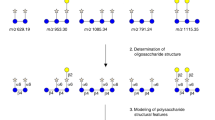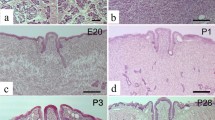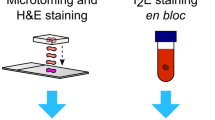Abstract
THE high solubility of monosaccharides makes the topochemical demonstration of these substances in animal cells and tissues very difficult. In 1948, Okamoto, Kadota and Aoyama1 described a method for the histochemical demonstration of sugars in tissue which is based on the insolubility of barium–glucose and barium–lactose in methyl alcohol. Gomori2 showed that the specificity of this method was not sufficiently tested and the topochemical demonstration was unlikely to be very accurate. Müller3 carried out tests with filter paper in order to discover whether it was possible to show the distribution of glucose by this method, and found a high specificity after fixation in a saturated solution of barium hydroxide in methyl alcohol. In experiments with animal tissues fixed at −10° C for 24 h he obtained a strong reaction, in liver cells, but kidney cells were negative. Using freezing substitution with saturated barium hydroxide–methyl alcohol solution, Geyer4 described the distribution of glucose in the kidney, and Stiller5 was able to demonstrate the presence of glucose in the mature human placenta using this modification. Ehrenbrand6 used cold microtome sections for the localization of glucose and probable galactose in the secreting mammary gland of hamsters.
This is a preview of subscription content, access via your institution
Access options
Subscribe to this journal
Receive 51 print issues and online access
$199.00 per year
only $3.90 per issue
Buy this article
- Purchase on Springer Link
- Instant access to full article PDF
Prices may be subject to local taxes which are calculated during checkout
Similar content being viewed by others
References
Okamoto, K., Kadota, I., and Aoyama, Z., Taishitzu Gakuzasshi, 14, 35 (1948) (cited by Gomori).
Gomori, G., Microscopic Histochemistry (Chicago, 1952).
Müller, G., Acta Histochem., 2, 73 (1956).
Geyer, G., Acta Histochem., 9, 329 (1960).
Stiller, D., Acta Histochem., 15, 185 (1963).
Ehrenbrand, F., Acta Histochem., 12, 337 (1951).
Author information
Authors and Affiliations
Rights and permissions
About this article
Cite this article
STILLER, D. Histochemical Demonstration of the Resorption of Xylose from Small Intestine. Nature 209, 924–925 (1966). https://doi.org/10.1038/209924a0
Issue Date:
DOI: https://doi.org/10.1038/209924a0
Comments
By submitting a comment you agree to abide by our Terms and Community Guidelines. If you find something abusive or that does not comply with our terms or guidelines please flag it as inappropriate.



